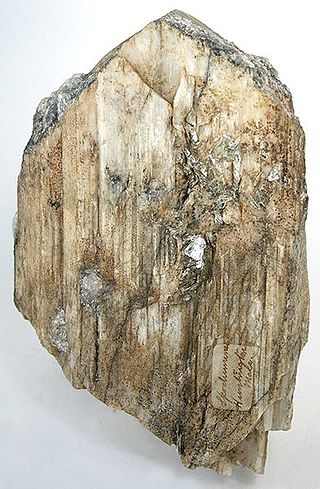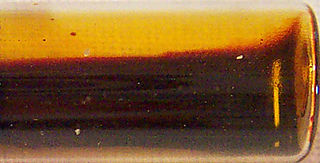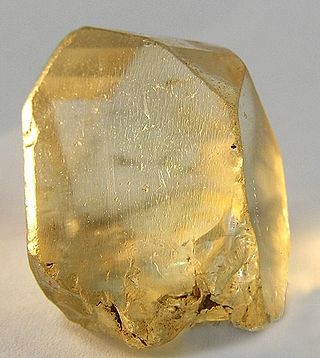Related Research Articles

Lithium carbonate is an inorganic compound, the lithium salt of carbonic acid with the formula Li
2CO
3. This white salt is widely used in processing metal oxides. It is on the World Health Organization's List of Essential Medicines for its efficacy in the treatment of mood disorders such as bipolar disorder.

Gaston County is a county in the U.S. state of North Carolina. As of the 2020 census, the population was 227,943. The county seat is Gastonia. Dallas served as the original county seat from 1846 until 1911.

Bessemer City is a small suburban city in Gaston County, North Carolina, United States. The population is 5,340. The city is approximately 6 miles (10 km) northwest of Gastonia and 25 miles (40 km) west of Charlotte. It was settled in 1756 and founded in 1893.

Spodumene is a pyroxene mineral consisting of lithium aluminium inosilicate, LiAl(SiO3)2, and is a commercially important source of lithium. It occurs as colorless to yellowish, purplish, or lilac kunzite (see below), yellowish-green or emerald-green hiddenite, prismatic crystals, often of great size. Single crystals of 14.3 m (47 ft) in size are reported from the Black Hills of South Dakota, United States.

Lithium hydroxide is an inorganic compound with the formula LiOH. It can exist as anhydrous or hydrated, and both forms are white hygroscopic solids. They are soluble in water and slightly soluble in ethanol. Both are available commercially. While classified as a strong base, lithium hydroxide is the weakest known alkali metal hydroxide.
Freeport-McMoRan Inc., often called Freeport, is an American mining company based in the Freeport-McMoRan Center, in Phoenix, Arizona. The company is the world's largest producer of molybdenum, is a major copper producer and operates the world's largest gold mine, the Grasberg mine in Papua, Indonesia.
Garth Drabinsky is a Canadian film and theatrical producer and entrepreneur. In 2009, he was convicted and sentenced to prison for fraud and forgery. The sentence was reduced from 7 to 5 years in prison, on appeal to the Ontario Court of Appeal, and the Supreme Court of Canada declined to hear a subsequent appeal. In April 2023, a judge dismissed Drabinsky’s defamation lawsuit against American Actor’s Equity for placing him on their ‘Do Not Work’ list.
In the mining industry or extractive metallurgy, beneficiation is any process that improves (benefits) the economic value of the ore by removing the gangue minerals, which results in a higher grade product and a waste stream (tailings). There are many different types of beneficiation, with each step furthering the concentration of the original ore.

Iron Ore Company of Canada is a Canadian-based producer of iron ore. The company was founded in 1949 by a partnership of Canadian and American firms. It is now owned by a new consortium, including the Mitsubishi and Rio Tinto corporations. Rio Tinto is the majority shareholder in the venture, with 58.7% of the joint stock as of October 2013. Mitsubishi controlled 26.2% of the investment as of March 2013.

Albemarle Corporation is an American specialty chemicals manufacturing company based in Charlotte, North Carolina. It operates 3 divisions: lithium, bromine specialties and catalysts.

FMC Corporation is an American chemical manufacturing company headquartered in Philadelphia, Pennsylvania, which originated as an insecticide producer in 1883 and later diversified into other industries. In 1941 at the beginning of US involvement in WWII, the company received a contract to design and build amphibious tracked landing vehicles for the United States Department of War, and afterwards the company continued to diversify its products. FMC employs 7,000 people worldwide, and had gross revenues of US$4.7 billion in 2018.

NMDC Limited, formerly National Mineral Development Corporation, is an Indian public sector undertaking involved in the exploration of iron ore, copper, rock phosphate, limestone, dolomite, gypsum, bentonite, magnesite, diamond, tin, tungsten, graphite, coal etc. It is India's largest iron ore producer and exporter, producing more than 35 million tonnes of iron ore from three mechanized mines in Chhattisgarh and Karnataka. It also operates the only mechanized diamond mine in the country at Panna in Madhya Pradesh.

The mining of minerals in Nigeria accounts for only 0.3% of its gross domestic product, due to the influence of its vast oil resources. The domestic mining industry is underdeveloped, leading to Nigeria having to import minerals that it could produce domestically, such as salt or iron ore. The rights to ownership of mineral resources is held by the Federal Government of Nigeria, which grants titles to organizations to explore, mine, and sell mineral resources. Organized mining began in 1903, when the Mineral Survey of the Northern Protectorates was created by the British colonial government. A year later, the Mineral Survey of the Southern Protectorates was founded. By the 1940s, Nigeria was a major producer of tin, columbite, and coal. The discovery of oil in 1956 hurt the mineral extraction industries, as government and industry both began to focus on this new resource. The Nigerian Civil War in the late 1960s led many expatriate mining experts to leave the country. Mining regulation is handled by the Ministry of Solid Minerals Development, who are tasked with the responsibility of overseeing the management of all mineral resources in Nigeria. Mining law is codified in the Federal Minerals and Mining Act of 1999. Historically, Nigeria's mining industry was monopolized by state-owned public corporations. This led to a decline in productivity in almost all mineral industries. The Obasanjo administration began a process of selling off government-owned corporations to private investors in 1999. The Nigerian Mining Industry has picked up since the "Economic Diversification Agenda", from Oil & Gas, to Agriculture, Mining, etc., began in the country.
Cherryville Township is a township in northwestern Gaston County, North Carolina, United States. As of the 2010 census it had a population of 16,500. It includes the incorporated city of Cherryville, the inactive incorporated town of Dellview, the unincorporated community of Tryon, and a portion of the town of High Shoals. It is represented on the Gaston County Board of Commissioners by Allen Fraley of Cherryville.
Crowders Mountain Township is a township in southwestern Gaston County, North Carolina, United States. At the 2010 census, it had a population of 15,821.
Allkem Limited, known as Orocobre Limited until 30 November 2021. Headquartered in Buenos Aires, Argentina, Allkem's portfolio includes lithium brine operations in Argentina, a hard-rock lithium operation in Australia and a lithium hydroxide conversion facility in Japan. Allkem is dual listed on the Australian Securities Exchange and Toronto Stock Exchange. In May 2023, Allkem agreed terms to merge with Livent.
Quebec Lithium Mine was a lithium mine in Quebec, Canada. The deposit was discovered in 1942 by Georges H. Dumont.

The Greenbushes lithium mine is an open-pit mining operation which is in Western Australia and is the world's largest hard-rock lithium mine. It is located to the south of the town of Greenbushes, Western Australia. The Greenbushes lithium mine produces approximately 1.95 million tonnes of lithium spodumene annually. The mine is 250 kilometres (160 mi) south of Perth and 90 kilometres (56 mi) southeast of the Port of Bunbury.
The Kenticha mine is a tantalum and lithium mine located in the Oromia Region of Southern Ethiopia. It is one of the largest tantalum reserves in the country, having estimated reserves of 116 million tonnes of ore grading 0.02% tantalum.
Piedmont Lithium is an Australian mining company in the process of proving economic mineral recovery of lithium in Gaston County, North Carolina.
References
- ↑ Ryan, Jack R. (December 12, 1954). "Expansion Pushed in Lithium Output; Use of Lightest Metal Is Now Ten Times Pre-War Rate -Demand Exceeds Supply". The New York Times. p. F1. Retrieved 2009-11-02.
- ↑ "LCA Mine (Lithium Corporation of America Mine), Bessemer City, Gaston Co., North Carolina, USA". mindat.org. Retrieved 2009-11-02.
- ↑ The New York Times (September 10, 1959). "Lithium Corp. Sued by Quebec Company". p. 53. Retrieved 2009-11-02.
- ↑ "FMC History". FMC Corporation. Archived from the original on 2009-07-09. Retrieved 2009-11-02.
- ↑ Lifton, Jack (September 1, 2006). "Reflections on Investing in the Future of Lithium". Resource Investor. Retrieved 2009-11-02.
- ↑ "Livent-Corporation-Announces-Completion-of-Separation-from-FMC-Corporation". Livent Corporation - News. Retrieved 2021-09-23.